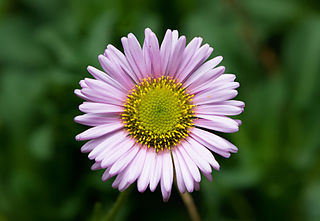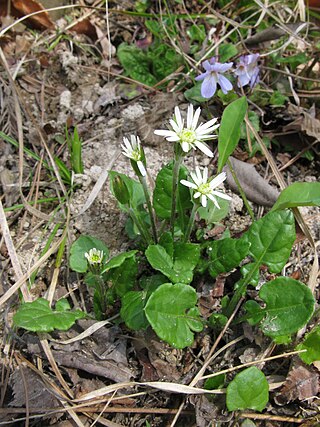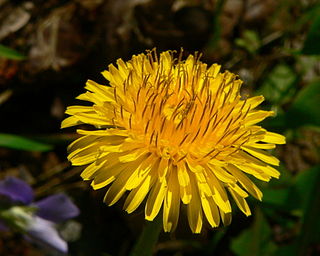Related Research Articles

Cirsium is a genus of perennial and biennial flowering plants in the Asteraceae, one of several genera known commonly as thistles. They are more precisely known as plume thistles. These differ from other thistle genera in having a seed with a pappus of feathered hairs on their achenes. The other genera have a pappus of simple unbranched hairs.

Carduus is a genus of flowering plants in the family Asteraceae, and the tribe Cardueae, one of two genera considered to be true thistles, the other being Cirsium. Plants of the genus are known commonly as plumeless thistles. They are native to temperate Eurasia and North Africa, and several are known elsewhere as introduced species. This genus is noted for its disproportionately high number of noxious weeds compared to other flowering plant genera.

Anaphalis is a genus of herbaceous and woody flowering plants within the family Asteraceae, whose members are commonly known by the name pearl or pearly everlasting. There are around 110 species with the vast majority being native to central and southern Asia. There is one species native to North America that is fairly well known and popular in cultivation, namely the western pearly everlasting.

Astereae is a tribe of plants in the family Asteraceae that includes annuals, biennials, perennials, subshrubs, shrubs, and trees. They are found primarily in temperate regions of the world. Plants within the tribe are present nearly worldwide divided into over 250 genera and more than 3,100 species, making it the second-largest tribe in the family behind Senecioneae.

Anthemideae is a tribe of flowering plants in the family, Asteraceae, and the subfamily Asteroideae. They are distributed worldwide with concentrations in central Asia, the Mediterranean Basin, and southern Africa. Most species of plant known as chamomile belong to genera of this tribe.

Pseudognaphalium is a genus of flowering plants in the sunflower family. Members of the genus are commonly known as cudweeds or rabbit tobacco. They are widespread in tropical and temperate regions of many countries.

Ajania is a genus of flowering plants in the daisy family, described as a genus in 1955. The genus is native to temperate Asia, primarily Russia and China. It is named after the Russian port city Ayan in the Khabarovsk Krai region of the Russian Far East, on the coast of the Sea of Okhotsk.

Leibnitzia (sunbonnets) is a genus of Asian and North American flowering plants in the family Asteraceae.

Crepidinae is a subtribe of Cichorieae in the family Asteraceae.
References
- ↑ "Cirsium Mill". Plants of the World Online . Royal Botanic Gardens, Kew . Retrieved 27 May 2023.
- ↑ Del Guacchio, Emanuele; Bureš, Petr; Iamonico, Duilio; Carucci, Francesca; De Luca, Daniele; Zedek, František; Caputo, Paolo (2022). "Towards a monophyletic classification of Cardueae: Restoration of the genus Lophiolepis (= Cirsium p.p.) and new circumscription of Epitrachys ". Plant Biosystems. 156 (5): 1269–1290. Bibcode:2022PBios.156.1269D. doi:10.1080/11263504.2022.2131924. S2CID 252700781.
- 1 2 3 4 5 6 7 8 9 10 11 12 13 14 15 16 17 18 19 20 21 22 23 24 25 26 27 28 29 30 31 32 33 34 35 36 37 38 39 40 41 42 43 44 45 46 47 48 49 50 51 52 53 54 55 56 57 58 59 60 61 62 63 64 65 66 67 68 69 70 71 72 73 74 75 76 77 78 79 80 81 82 83 Ackerfield, Jennifer; et al. (2020). "A prickly puzzle: Generic delimitations in the Carduus-Cirsium group (Compositae: Cardueae: Carduinae)". Taxon. 69 (4): 715–738. doi:10.1002/tax.12288.
- 1 2 3 4 5 6 7 8 9 10 11 12 13 14 15 16 17 18 19 20 21 22 23 24 25 26 27 28 29 30 31 32 33 34 35 36 37 38 39 40 41 42 43 44 45 46 47 Bureš, Petr; et al. (2023-02-27). "Evolution of genome size and GC content in the tribe Carduinae (Asteraceae): rare descending dysploidy and polyploidy, limited environmental control and strong phylogenetic signal". Preslia. 95 (1): 185–213. doi: 10.23855/preslia.2023.185 . eISSN 2570-950X.
- 1 2 3 4 5 6 7 8 9 10 11 12 13 14 15 16 17 18 19 20 21 22 23 24 25 26 27 28 29 30 31 32 33 34 35 36 37 38 39 40 Лукьяновна Харадзе, Анна (2001) [originally published 1963 in Russian]. "Cirsium". Flora Unionis Rerumpublicarum Socialisticarum Sovieticarum. Vol. 28. Translated by Dhote, A. K. Science publishers. pp. 51–213. ISBN 9781886106451.
- ↑ Bureš, Petr; et al. (2024-05-05). "Intergeneric hybrid origin of the invasive tetraploid Cirsium vulgare". Plant Biology. doi: 10.1111/plb.13653 . ISSN 1438-8677. PMID 38704835.
- ↑ Werner, Klaus (1976). "Cirsium Miller". Flora Europaea. Vol. 4. pp. 232–242. ISBN 0-521-08717-1.
- ↑ Bureš, Petr; Knoll, Aleš; Michálková, Ester; Šmarda, Petr; Šmerda, Jakub; Vavrinec, Martin (2018-05-09). "Cirsium greimleri: a new species of thistle endemic to the Eastern Alps and Dinarides". Preslia. 90 (2): 105–134. doi: 10.23855/preslia.2018.105 . eISSN 2570-950X.